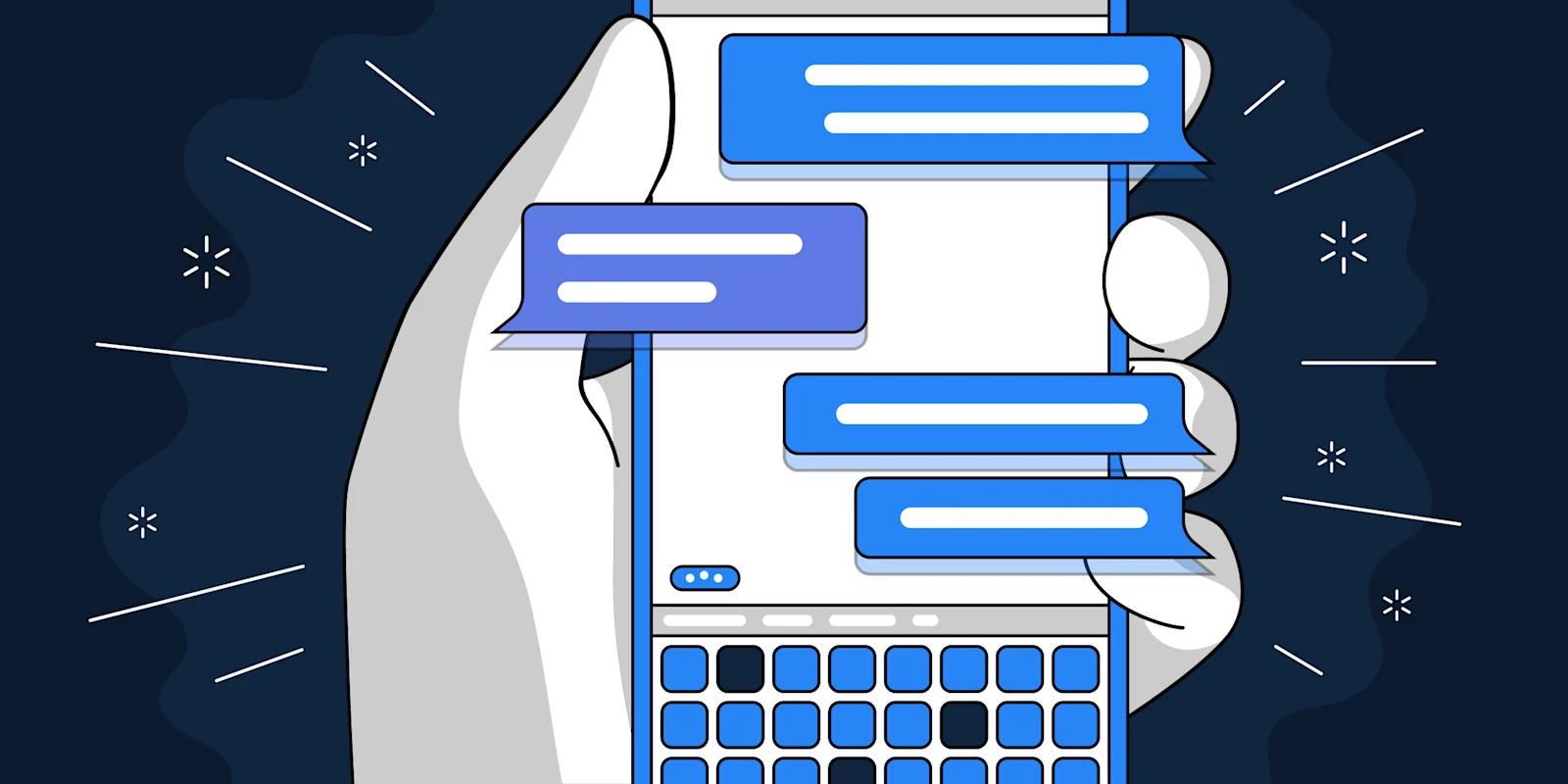Did you know that 1.4 billion people use messaging apps and that the majority of these users are willing to consult a chatbot? We knew that, but still, our chatbot development execution was not so great.
It takes thought and effort to implement a chatbot design system to function exactly how you want it to.
In this post, we’ll explain what a chatbot is, how chatbot marketing works, and how we designed our HubSpot chatbot to improve the user experience for our website visitors and clients.
What is Chatbot Marketing?
Chatbot marketing is the practice of deploying an automated robot (i.e. software) to interact with prospects and customers, on a website or app, to automate tasks through the conversation.
Chatbots can be configured by humans to qualify leads to increase conversions with great UX, answer customer support questions, schedule a meeting, guide them through a custom marketing funnel, or generate sales.
See? Chatbots don’t need to be overcomplicated. Because there are different types of chatbots, let’s explore a few of the popular options.
Types of Chatbots
What makes chatbots powerful is that you can build them to perform practically any automated task that is important to your marketing strategy.
In other words, you can build a chatbot for anything (as long as it’s Rated-G for clients).
1. SMS Chatbot
A common type of chatbot that we all know of is used in SMS marketing, which is promotional marketing through text messaging (SMS).
2. Support Chatbot
Another chatbot example is a support chatbot or customer service chatbot.
IBM reported customer support chatbots can help businesses save up to 30% on their costs. Support chatbots are designed to solve a specific pain point for a website visitor, walk them through a well-defined business process, or answer FAQs
We built our HubSpot chatbot to support our customers! But first, here's how chatbots came to exist in the first place.
Why is Chatbot Marketing So Popular?
Did you know that the first AI chatbot was developed back in 1966 to trick people into believing that they were talking to a therapist in real-time? Project ELIZA has paved the way for the evolving chatbot market, worth 100s of millions today!
Chatbots today can be used to solve many different business needs, and they’re ubiquitous in the world of digital marketing. With in-person activities replaced by online experiences because of the COVID-19 pandemic, 2020 was aptly termed “the year of the bot.”
From big tech companies to small and medium-sized businesses, chatbots are becoming the ‘future of engagement’ as they continue to improve digital customer experiences.
What Makes a Chatbot Unique?
Growing a whopping 92% since 2019, chatbots are the largest growing communication channel.
We think chatbots are unique because they’re built by us - humans - to alleviate customer pain points quickly and painlessly like non-invasive surgery.
Because today’s consumers are well-informed, we don’t need to sell them on the idea that it’s a human on the other side of the chatbox, but use technology to make their lives easier.
The biggest mistake we see businesses make is putting a human face behind the chatbot. Why open your business to reputation risk and lie to website visitors?
What makes chatbots unique is that humans can program them to improve the customer experience and personalize the user experience based on customer interests and goals.
If you build the perfect chatbot, then you’ll attain user data that can be deployed to facilitate lead generation and conversation. Unfortunately for us, that wasn’t the case for our first chatbot.
How Our Previous Chatbot Failed to Feel Personalized
Rome wasn’t built in a day and neither will a perfect chatbot. That was our experience at least.
Working towards your ideal chatbot will require multiple iterations. We found our public beta chatbot lacked a truly personalized experience based on the intent of the user.
This was our fatal flaw: All paths lead to sales, but talking to sales did not match the intent of every visitor on our website.
Bots should not be a one-size-fits-all solution. Your chatbot should aim to provide a dynamic experience whether a visitor is there to explore, learn, evaluate, or make a purchase.
Each of these intents should be mapped to tasks like helping visitors read a relevant blog, download sales collateral, or chat with your sales team if they are ready to make a purchase.
Each path should be visible and smooth, indicating clear prioritization of your visitors’ intent.
How We Developed Our New Chatbot
For Webstacks chatbot 2.0, we put the user in the driver's seat, granting them the power to dictate the flow of the conversation. To do this, we had to reexamine the HubSpot flywheel model.
We were committed to building an improved chatbot that would meet visitors where they are in the buyer’s journey, and serve helpful solutions at every stage: attract, engage, and delight.
Our Chatbot Framework
A chatbot is *literally* a lead-generating machine, but a well-designed chatbot is so much more.
We want our chatbot to serve as a concierge, a resource distribution machine, a customer service agent, and yes, ultimately a well-oiled lead generating machine.
To achieve this, we included menus and tons of tasteful automation. Most importantly, we created multiple pathways for our visitors to follow that don’t all end with a salesperson.
Designing a Chatbot for Errors
Having a bunch of unique pathways is a fantastic solution to leading everyone to a sales call, but it can frustrate visitors if they run into dead-ends.
At Webstacks, we value team members and clients that break down walls, so we set out to design a chatbot that shares the same company values.
Our new, multi-branched chatbot design framework allows users to easily navigate from our “explore the website” path to our “book a meeting with sales,” path and back without having to start a new chat.
While not all errors can be controlled for, with a mapped chatbot framework, internal QA testing, and unambiguous text that matches your visitor’s intent you can limit errors.
Also, if you require visitors to type information like phone numbers or emails, make sure you write descriptive error messages to indicate what they need to change to complete their task.
Embracing Our Customer Service Chatbot
In 2018 Gartner predicted that 85% of all customer interactions would be powered by chatbots.
Safe to say we see this trending towards truth.
Now, we can’t all be Amazon, but we can keep our company resources in mind when we design our chatbot to improve our customer’s experience.
In 2021 no one wants to pick up the phone and sit on hold. Today’s consumers want instant access to chat with someone or find the answer to an immediate problem.
With HubSpot’s chatbot marketing tool and service Hub you can do just that. Create tickets, answer questions, direct visitors to your knowledge base, and provide direct help via live chat.
Why Chatbots are a Form of Conversational Design
A 2018 study by Drift found that Baby Boomers were 24% more likely to find value in chatbot exchanges than Millennials.
That makes sense. Baby Boomers used to wait months for something they ordered in a catalog.
With the prevalence of free and next-day shipping, few millennials would order something with a 2-week delivery date. Millennials are a tricky bunch, but that’s where design comes in.
Today’s consumers have high expectations, and digital marketing agencies need to put the effort in to exceed expectations. Who knows, a well-designed chatbot could even please Gen Z!
Gauge User Intent with Conversational Design
Ok, so we know we need a well-designed chatbot - how do we build one?
Keep the users intent in mind. Ask yourself these questions when evaluating specific pages:
- Why do users visit this page?
- What might they be trying to accomplish?
- What is the next step after this page?
If visitors are there to learn, the chatbot should be focused on helping them learn, if they are there to find a resource, help them download a guide, and if they are there to talk to sales, then send them to a member of your sales team.
Gauging intent is important, but you have to think through your automation to ensure your user flows through the conversation effortlessly with no dead-ends in the user experience.
If you’re still not convinced by a conversational design framework or are wary of the topic, check out our post on conversational marketing.
We break down different types of conversational frameworks that high-growth marketing teams are implementing today. Also, take a gander at our HubSpot services and see what we offer. We'd be happy to start the conversation!
Until then, keep breaking down walls!




